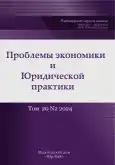Econometric Analysis of the Labor Market in the North Caucasus Region
- 作者: Dzgoev R.B.1, Krasulin L.A.2,3, Tregub I.V.2
-
隶属关系:
- ATB Bank
- Financial University under the Government of the Russian Federation
- JSC «Norsi-trans»
- 期: 卷 20, 编号 2 (2024)
- 页面: 202-210
- 栏目: Mathematical, Statistical and Instrumental Methods in Economics
- URL: https://journals.eco-vector.com/2541-8025/article/view/633819
- DOI: https://doi.org/10.33693/2541-8025-2024-20-2-202-210
- EDN: https://elibrary.ru/OQMVOX
- ID: 633819
如何引用文章
详细
The purpose of this study is an econometric analysis of the labor market in the North Caucasus region in the Russian Federation. The article examines the main indicators characterizing the labor market, such as the average monthly nominal accrued wages of workers across the entire spectrum of economic organizations as a whole by business entities, the real average monthly accrued wages of workers, the share of the number of workers employed in work with harmful and/or dangerous conditions labor in organizations, Labor productivity index, Level of innovative activity of organizations, Degree of depreciation of fixed assets in the constituent entities of the Russian Federation of the Russian Federation across the entire spectrum of organizations, Consumer price indices for all goods and services by subject at the end of the period, Number of graduates of higher educational institutions that have a direct impact on the level of unemployment and labor force in the region. The relevance of the chosen topic is due to the study of the role of these indicators in the analysis of the region’s activities in an economic and social key. The structure of the article provides for a consistent presentation of the results of the analysis of each of the models, an assessment of their adequacy and explanatory power, as well as an interpretation of the obtained modeling results. Particular attention is paid to how changes in economic indicators and policies can affect the labor market and unemployment rates in the region. In conclusion, conclusions based on the results of the study are formulated and recommendations are proposed to stimulate economic growth and reduce unemployment in the North Caucasus Federal District.
全文:
作者简介
Ruslan Dzgoev
ATB Bank
Email: rusdzgoev@yandex.ru
специалист по работе с крупными иностранными клиентами
俄罗斯联邦, MoscowLev Krasulin
Financial University under the Government of the Russian Federation; JSC «Norsi-trans»
Email: l.a.krasulin@gmail.com
SPIN 代码: 7137-8206
Faculty of Information Technologies and Big Data Analysis, Technical support specialist
俄罗斯联邦, Moscow; MoscowIlona Tregub
Financial University under the Government of the Russian Federation
编辑信件的主要联系方式.
Email: itregub@fa.ru
ORCID iD: 0000-0001-7329-8344
SPIN 代码: 2192-9453
Scopus 作者 ID: 57189715735
Researcher ID: A-5855-2017
Dr. Sci. (Econ.), Professor
俄罗斯联邦, Moscow参考
- URL: https://cyberleninka.ru/article/n/ekonomicheskiy-rost-severo-kavkazskogo-makroregiona-v-usloviyah-globalizatsii-indeks-usloviy-vneshney-torgovli-ekonometricheskaya (date of application: 31.03.2024).
- URL: https://cyberleninka.ru/article/n/srednesrochnyy-prognoz-ekonomicheskogo-rosta-severo-kavkazskogo-makroregiona-na-osnove-ols-metoda-i-panelnyh-dannyh (date of application: 31.03.2024).
- URL: https://cyberleninka.ru/article/n/innovatsionnoe-razvitie-promyshlennosti-regiona-i-ego-rol-v-formirovanii-konkurentosposobnyh-proizvodstv (date of application: 31.03.2024).
- URL: https://cyberleninka.ru/article/n/import-substitution-of-agricultural-products-as-a-factor-of-sustainable-development-the-north-caucasus-federal-district (date of application: 31.03.2024).
- Becker, G. S. (1964). Human capital: a theoretical and empirical analysis, with a special focus on education. University of Chicago Press.
- Blundell R. and Makurdi T. (1999). Labor supply: an overview of analytical materials. In O. Aschenfelter and D. Card (eds.), Handbook of Labor Economics (Volume 3A, 1559–1695).
- Gichiev N.S. Economic growth of the North Caucasian macroregion in the context of globalization: index of foreign trade conditions, econometric growth model // RPE. 2018. No.12 (98). URL: https://cyberleninka.ru/article/n/ekonomicheskiy-rost-severo-kavkazskogo-makroregiona-v-usloviyah-globalizatsii-indeks-usloviy-vneshney-torgovli-ekonometricheskaya (date of application: 03/31/2024).
- Gichev N.S. Medium-term forecast of economic development of the North Caucasian macrogroup based on the method and results of the analysis // RPPZ. 2021. No. 10 (132). URL: https://cyberleninka.ru/article/n/srednesrochnyy-prognoz-ekonomicheskogo-rosta-severo-kavkazskogo-makroregiona-na-osnove-ols-metoda-i-panelnyh-dannyh (date of application: 03/31/2024).
- Idziev G. I., Tsapieva O. K., Esetova A.M. Innovative development of industry in the region and its role in the formation of competitive industries // PSE. 2012. No.2. URL: https://cyberleninka.ru/article/n/innovatsionnoe-razvitie-promyshlennosti-regiona-i-ego-rol-v-formirovanii-konkurentosposobnyh-proizvodstv (date of reference: 03/31/2024).
- Card, D. (1999). Directly-government influence on the results. In O. Aschenfelter and D. Card (eds.), «Handbook of Equestrian Labor» (Volume 3, 1801–1863). Elzevir.
- Mecherakova Zh.V., Skorkina N.V., Khalupovsky I.M. Import substitution of agricultural products as a factor of sustainable development of the North Caucasus Federal District // Economics and Business: theory and practice. 2018. No.7. URL: https://cyberleninka.ru/article/n/import-substitution-of-agricultural-products-as-a-factor-of-sustainable-development-the-north-caucasus-federal-district (date of application: 03/31/2024).
- Pissarides, K. A. Theory of equilibrium unemployment. Publishing House of the Massachusetts Institute of Technology. 2000.
- Myaktinova T.A., Tregub I.V. Is it worth studying longer? Econometric assessment of the impact of education // Accounting and statistics. 2022. No. 4 (68). pp. 103–112.
- Tregub I.V. Development of economic tools for stabilizing the economy of the region: the experience of the Yaroslavl region // Management and politics. 2022. Vol. 1. No. 3. pp. 27–34.














